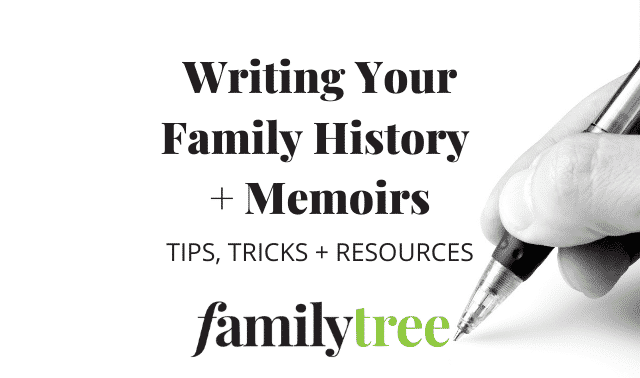Sign up for the Family Tree Newsletter! Plus, you’ll receive our 10 Essential Genealogy Research Forms PDF as a special thank you.
Get Your Free Genealogy Forms
"*" indicates required fields
When was the last time you read a biography or work of historical fiction and felt a kindred connection with the main character? By the story’s end, this person may have seemed like a friend who taught you about life. Isn’t that the goal of writing a family history story—to help readers form an emotional connection with their ancestors?
You can craft a story that swells beyond a biographical sketch. If you do your job well, your words will inspire future generations and bring relatives closer to their past.
Here are 12 tricks for doing just that.
1. Start by Asking: Who is the Main Character?
This first point might seem obvious, but the answer may require closer examination than you realize. Your story should be about someone and should revolve around their journey. The best stories generally center on an individual, while a supporting cast fills essential roles in the plot.
It is possible to write a story featuring two people, such as a couple, best friends, or siblings. Sometimes, family storytelling centers around the saga of an entire generation or sibling set. For example, a family’s immigration story is a crucial moment that changes their trajectory. In such a story, the family unit is in it together like a collective main character. But this case is often an exception to the rule. If you see more than one important character, decide if your tale will split attention equally or whether one is the lead.
2. Recognize the Protagonist as One Whose Fate Drives the Story
In his Writer’s Workshop, Stephen Koch states that the protagonist is the character whose fate matters most to the story. Let’s examine the classic movie/musical The Sound of Music, as it is based on a true story (albeit loosely). This family saga is set in Austria and chronicles what happened to the Von Trapp family during World War II. Rogers & Hammerstein could have focused on any member of this family or split the airtime equally, but Maria gets the spotlight.
According to Koch’s definition of the protagonist, the fate of the Von Trapp family rests on Maria coming to live with them and ultimately becoming one of them. Part of what makes this film so satisfying is that every member of this family changes—including Maria—but she is the catalyst.
An alternate definition comes from the late great Blake Snyder, whose Save the Cat series of books influenced a generation of filmmakers. Snyder said that the main character is the one who grows and changes the most. Snyder uses the example of the movie Rain Man, which is based on a true story. Viewers initially sympathize with Dustin Hoffman’s character, Raymond Babbitt. However, Snyder points to the selfish brother Charlie, played by Tom Cruise, as the main protagonist. Charlie is the one who becomes a better man, while Raymond changes little from the beginning to the end. Yes, Raymond is the catalyst for Charlie’s transformation, but Charlie must make decisions throughout. His choices drive the story forward. Ultimately, the audience feels satisfied seeing Charlie transform into a good guy deserving of his brother’s loyalty.
3. Include Physical Descriptions and Look Beyond the Obvious
Formal family history books are generally written in a third-person biographical voice. In a project like this, you will want to refrain from overstepping the truth with flowery descriptions that border on fiction. Instead of veering into conjecture, focus on discovering details that hint at personality. Photographs may indicate their wealth, personality and other key qualities. Were they dressed in the latest fashions, or did their Sunday best look well-worn?
You may be delighted to find physical details in military or death records. Obituaries and eulogies sometimes contain colorful descriptions. City Directories and Gazetteers often provide occupations. From a person’s work, you might infer printer’s ink on the hands, wood shavings in the hair, or the well-groomed appearance of a banker. Newspaper articles—especially society pages—might reveal their travels, parties they hosted, and membership in civic groups. If they belonged to an organization that kept minutes, you might be lucky enough to unearth quotes in their voice or causes they supported.
Consider including some of these descriptions:
- Eyes, hands, and voice
- Gait and walking cadence
- Their scent
- Occupational dress
- Birth order
- Whether they look like other members of a family or not
- Special talents
- Social proclivity
- Membership in organizations
- Whether they were a parent or not
- How many times they were married, or not
- Mannerisms and quirks that make them relatable
- Ways the person changed with time
4. Introduce Your Character Right Before the Action Starts
Great storytelling begins by introducing readers to the setting and the main character. The opening scene is a warmup that establishes the time, place, and the story’s tone. Here is an opener that does this well, from the classic Memoir Out of Africa by Danish author Karen Blixen: “I had a farm in Africa, at the foot of the Ngong Hills . . . Up in this high air you breathed easily . . . you woke up in the morning and thought: Here I am, where I ought to be.”
This excerpt shows that this is a first-person story about Karen. It takes place in Africa, a place that is beloved to her. In a few words, we sense that this will be a rich and nostalgic story.
In your opening scene, introduce your main character shortly before an important event happens. That event is called an inciting incident. This event may be something the hero did not see coming, but it sets off a chain reaction that requires action. Before the inciting incident, however, describe your character on a typical day. Show them at home, at work, or at play.
5. Make Readers Care
Above all, your goal is to make the reader care. You want them to feel personally invested in the character’s success (in this case, your ancestor). The most important message to convey about a character is what they value. What matters most to them? What are they willing to fight for? We identify with people when we understand what they believe, so look for factual details that indicate why they made their choices.
You can also win readers over by showing the character’s struggle. There is a reason so many child protagonists in fiction are orphans. This trick might seem overdone, but it keeps working. When we see a grieving or abandoned child, we feel for their plight. Readers want this child to triumph over grief and adversity. Understanding the backstory also softens judgment when a character acts out or withdraws.
In writing about your ancestor, you might show how they overcame an illness or an intrepid journey to a new place. Most people feel like a misfit in some way or have experienced loneliness. Readers form emotional connections with others who struggle.
6. Remember: Heroes Act
True heroes act; they are not acted upon. Avoid writing characters who are tossed about by the winds of fate. Instead, show them taking chances that change the course of their life. Strong characters make good or questionable choices and accept the consequences. If your story seems weak, strengthen it by showing your hero taking charge of their life. Think of an ancestor who set sail for a new life or an abused spouse who finally left. These choices take guts. Readers side with an underdog worthy of cheering through the journey.
7. Show Their Good Side
Show a character who changes through the story. In the beginning, you will paint them as imperfect with room for growth. But don’t overdo the flaws. Thread the needle by showing how they are human yet still likable. Writers often make complex characters more sympathetic by showing them having a selfless act early in the story. For example, if your ancestor was not particularly kind man but you still want to show how his early life shaped him, you might offer generous descriptions of his childhood to illustrate why his past might have influenced his more recent behavior.
8. Handle Unflattering Details with Sensitivity
If someone in your family story makes a mistake, examine the context to help readers understand the time and culture. Even if what they did was inexcusable at any age, show their error in the context of a broader life. Surely, they did something redeeming, right? Sometimes, just surviving a difficult time in history is a worthy feat.
Another way to write an ancestor complex character is to examine how their strengths may sometimes present as weaknesses. A person’s biggest weakness often stems from their strength taken to the extreme.
If your ancestor’s regrets are known, consider writing about that. Not everyone is comfortable talking about mistakes, but if a person is brave, their story can provide a powerful warning to others who might make the same mistakes. Plus, readers relate to vulnerability.
9. Highlight Some Endearing Quirks
In addition to fleshing out your ancestor’s weaknesses, be sure to recall some of their special traits that make them memorable as well. Lighten the narrative by including antics, tics, or other foibles without being mean-spirited. Author and famed music producer Rick Rubin says, “Humanity breathes in the mistakes.” Characters who are too perfect lose credibility.
10. Identify Their Nemesis
In fiction, the villain makes the hero. Think about the adversity that your character faced. Opposition might come from bullies, authority figures, or people who represent old ways of thinking. They may experience poverty, prejudice, war, or the physical elements. Your character may run afoul of institutions that fight change.
Caution: When writing “bad guys,” avoid painting a real person as pure evil. If your story has a villain, consider thoroughly disguising their identity or creating a composite character.
11. Give Characters a Unique Voice
Voice is unique and intimate. If you are writing about a living person, consider conducting an oral history interview. You could use the audio to create a video or quote their words in a written piece.
Authentic dialogue adds substance to a piece. Pull short quotes from journals, letters, or articles. You can tune your ear for dialogue by cataloging regional expressions or the jokes of an era. There is wisdom unique to every region’s language.
However, when writing regional dialect, try to use your best judgment, as forcing dialects in writing can at times come across as insensitive. Use phonetic spellings sparingly and only when doing so would elevate a culture. Never take a superior tone that implies someone else’s accent is a mark of low intelligence. Ask someone else to read it for sensitivity.
12. Limit the Cast to Essential Players
Effective storytelling limits the number of tangential characters. Readers will get confused and bored if you throw in too many friends and neighbors. Give each character a unique physical description and way of speaking so they are memorable. If you do not have enough space to put some meat on their stick-figure frame, it is better to leave them out entirely.
Ask: is this person important for the plot? Do they have a growth trajectory?
If you worry that leaving someone out might hurt feelings, consider including them in a list of acknowledgments, on a family tree, or in a section of photos.
Helpful Definitions:
- Arc: A character’s arc is their transformational journey. In other words, it is their growth trajectory from the beginning to the story’s end.
- Deuteragonist: This word comes from Greek and means “second actor” or a secondary main character. This character acts as a constant companion and actively supports the hero. Think of Samwise Gamgee in Lord of the Rings or a supportive spouse.
- Ensemble cast: In this type of story, the narrative divides focus between a broader cast of characters with equal importance. Each character drives their own story. An ensemble cast is hard to pull off, but it can be done. Some of the best examples come from television shows because producers have multiple seasons to explore everyone’s lives. Think Friends or Stranger Things.
- Inciting incident: An event early in the story that sets a character on their journey of growth. This moment is what starts the story in earnest.
- Parallel storyline, or multiple viewpoints: This story features two or more characters equally and may shift points of view from one to another throughout the tale.
- Protagonist: This is the main character of a story, sometimes also called a hero. Note that in fiction, not every protagonist is a hero. (Think Macbeth).
Related Reads
Last updated: February 2025










